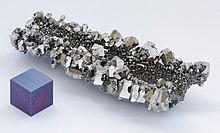FIELDS




FIELDS is a science instrument on the Parker Solar Probe (PSP), designed to measure magnetic fields in the solar corona during its mission to study the Sun.[1] It is one of four major investigations on board PSP, along with WISPR, ISOIS, and SWEAP.[1] It features three magnetometers.[1] FIELDS is planned to help answer an enduring questions about the Sun, such as why the solar corona is so hot compared to the surface of the Sun and why the solar wind is so fast (a million miles per hour).[2]
The host spacecraft, Parker Solar Probe, was launched by a Delta IV Heavy on August 12, 2018 from Florida, USA.[3] On August 13, 2018 FIELDS became the first instrument to be activated including beginning deployment of the four whip antennas (clamps unlocked) and extension of the magnetometer boom.[4] On September 4, 2018 the whip antennas were deployed.[5]
Overview
[edit]FIELDS features three magnetometers: two are fluxgate magnetometers, and the third is a search-coil magnetometer.[1] It has five voltage sensors, four of which extend beyond the spacecraft's heatshield and must directly endure the intense conditions at the planned distances of less than 10 solar radii to the Sun.[6][7]
For best scientific observations, the spacecraft must approach to approximately about 10 solar radii (4% of the Earth-Sun distance) to take measurements from within the solar corona.[8] The task of FIELDS is to take measurements of the electrical and magnetic fields near the Sun.[2] Most of FIELDS instrumentation is protected, along with the bulk of the spacecraft by a special 4.5 inch (11.43 cm) thick carbon heatshield as the spacecraft is expected to endure temperatures of 2,500 degrees F.[9] While the surface of the Sun is roughly 10,000 degrees F, the solar corona has a temperature exceeding 1 million°F.[2] (about half a million°C)
Planned measurements include:[10]
- electric and magnetic fields and waves
- Alfven waves and turbulence[11]
- poynting flux
- absolute plasma density
- electron temperature
- spacecraft floating potential and density fluctuations
- radio emissions
Components
[edit]The key components of FIELDS are:[8][1]
- Five voltage sensors
- Two fluxgate magnetometers
- One search-coil magnetometer
- Main Electronics Package
Supporting systems include four whip antennas (called V1 through V4) that are 2 meters long and made of C-103 niobium alloy.[1] These antennas are numbered V1, V2, V3, and V4.[1] V5 is a voltage sensor on the end of the spacecraft's magnetometer boom. All five send signals to the Antenna Electronics Board which is part of the Main Electronics Package, and each V1 to V5 has its own pre-amplifier that is sending this signal.[1] The sensors are integrated with various electrical and electronic processing systems which take in the raw signals and convert them into software data for transmission back to Earth by radio communication.[1]
The FIELDS experiment can also detect cosmic dust, by recording the dust impact strikes on the antennas.[12] It will try to detect micron sized and nanodust, if carried by the solar wind.[13][14] It detects and sizes dust impacts on its antennas by the voltage signature.[14]
Operations
[edit]By September 2018, FIELDS had been turned on and first data was returned.[15] Data from FIELDS was designed for return from observations during the closer solar encounters of the Parker Solar Probe spacecraft in October–November 2018 and March–April 2019.[16]
Timeline
[edit]- August 12, 2018; launched.
- August 13, 2018; FIELDS instrument is powered on in outer space.[17]
- September 4, 2018 - four whip antennas deployed/extended.[5][19]
See also
[edit]- Interior Characterization of Europa using Magnetometry, a planned magnetometer for Europa Clipper
- Magnetometer (Juno), a magnetometer on board Juno Jupiter orbiter
- Spacecraft magnetometer
References
[edit]- ^ a b c d e f g h i Bale, S. D.; Goetz, K.; Harvey, P. R.; Turin, P.; Bonnell, J. W.; Dudok de Wit, T.; Ergun, R. E.; MacDowall, R. J.; Pulupa, M.; et al. (2016-03-31). "The FIELDS Instrument Suite for Solar Probe Plus". Space Science Reviews. 204 (1–4): 49–82. doi:10.1007/s11214-016-0244-5. ISSN 0038-6308. PMC 5942226. PMID 29755144.
- ^ a b c "Here comes the sun: New spacecraft to fly closer than ever before". CU Boulder Today. 2018-08-08. Retrieved 2018-08-18.
- ^ Brown, Geoffrey; Brown, Dwayne; Fox, Karen (August 12, 2018). "Parker Solar Probe Launches on Historic Journey to Touch the Sun". Parker Solar Probe. Retrieved August 13, 2018.
- ^ a b "Parker Solar Probe Marks First Mission Milestones on Voyage to Sun – Parker Solar Probe". blogs.nasa.gov. 17 August 2018. Retrieved 2018-08-19.
- ^ a b "NASA's Parker Solar Probe brings instruments and secondary systems online ahead of schedule | V3". V3. Retrieved 2018-09-12.
- ^ Garner, Rob (2018-07-12). "Parker Solar Probe Instruments". NASA. Archived from the original on 2018-08-11. Retrieved 2018-08-17.
- ^ "NASA Press Kit: Parker Solar Probe" (PDF). NASA. Retrieved 15 August 2018.
- ^ a b Cheng, Weilun; Kee, Calvin; Wirzburger, John. Parker Solar Probe MAG Boom Design, Analysis and Verification (PDF) (Report). Retrieved December 3, 2022.
- ^ "NASA Probe That Will Touch Sun Set to Launch August 11". Fortune. Retrieved 2018-08-18.
- ^ JHUAPL. "Parker Solar Probe: Spacecraft". parkersolarprobe.jhuapl.edu. Retrieved 2018-08-17.
- ^ "Satellite Mission Catalogue - Parker Solar Probe". eoportal.org. July 21, 2016. Retrieved November 12, 2022.
- ^ Kasper, Justin C. "The SWEAP Investigation for Parker Solar Probe". www.cfa.harvard.edu. Retrieved 2018-08-17.
- ^ "Parker Solar Probe - eoPortal Directory - Satellite Missions". directory.eoportal.org. Retrieved 2018-09-10.
- ^ a b "Parker Solar Probe/FIELDS Science – PSP/FIELDS". UC Berkeley. Retrieved November 30, 2022.
- ^ "Illuminating First Light Data from Parker Solar Probe – Parker Solar Probe". blogs.nasa.gov. 19 September 2018. Retrieved 2018-12-23.
- ^ "The FIELDS Experiment for the Parker Solar Probe". UC Berkeley. Retrieved November 30, 2022.
- ^ "NASA Solar Probe Hits 1st Deep-Space Milestones On Its Way to the Sun". Space.com. Retrieved 2018-08-18.
- ^ "Parker Solar Probe Operating as Planned, NASA Says". NDTV Gadgets360.com. Retrieved 2018-08-18.
- ^ "Parker Solar Probe". blogs.nasa.gov. Retrieved 2018-09-12.

